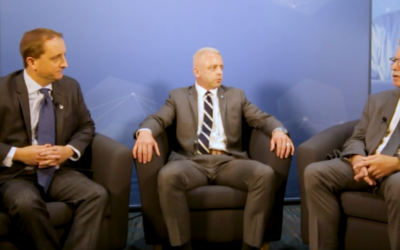Carpal Tunnel Considerations In Neuromonitoring
In the neurodiagnostic world, evaluating carpal tunnel syndrome is one of their bread-and-butter studies. For surgical neurophysiologist who works in the operating room, the topic of median nerve compression at the wrist does not come up very much.
If you happen to see it in the patient’s history or discover it during the patient interview, then you can just elect to work around it. Instead of using the abductor pollicus brevis for transcranial motor evoked potentials and electromyography, you can just use the adductor digiti minimi or the first dorsal interosseous muscle (both innervated by the ulnar nerve). For somatosensory evoked potentials, we place both the cathode and anode proximal to the carpal tunnel, so any distal compression should not affect the conductivity of the nerve proximal to the site of compression.
Problem solved.
But what many neuromonitoring technicians and oversight physicians tend to overlook is the central consequences of these peripheral deficits. This has been extensively studied in both animals and humans and changes can be seen in cortical structures (and a huge topic of discussion for chiropractors).
It’s not that I think most fail to understand the concept of central reorganization after peripheral deafferentation. Most are familiar with changes in somatotopic representation in a person with a limb amputation. I just think that it isn’t given enough appreciation for those trying to optimize neurophysiological monitoring signals in the operating room.
Allow me to do something stupid and use my limited observations to formulate an opinion on an entire industry.

I believe the neuromonitoring community:
- Discounts change in the central processing in patients with peripheral nerve deficits. Or at least the ones that aren’t as obvious as someone with an amputation or significant muscle wasting.
- Underappreciates the speed at which reorganization can take place. There is immediate disinhibition of pre-existing thalamocortical projections arising from receptor territories in close proximity to the deafferented area causing short-term changes. Other processes, like an increase in the number of synapses and improvement of synaptic efficiency, happen over a longer period of time.
- Fails to consider that neuroplasticity is not limited to cortical structures. There is reorganization along the entire central pathway in order to accommodate for the loss in afferent feedback.
- Feel uneasy getting away from standard protocols, even in instances where other options should be considered.
Unlike positron emission tomography (PET scan), we have modalities that can assess both cortical and subcortical structures. SSEP is a very easy technique to use to assess changes in the spinal cord, brainstem, and thalamocortical projections. And that is what the (Tinazzi, 1998) paper looked at.
Peripheral Nerve Compression And Central Consequences of Carpal Tunnel Syndrome In Neuromonitoring
They took a population of people that had right sided carpal tunnel syndrome only. They ran ulnar nerve SSEP on the affected and unaffected hand. They found a significant difference in the amplitude of the affected hand vs the unaffected hand at the cervical, brainstem and cortical channels.
They also compared the results of the test subjects to a very similar control group that had no carpal tunnel syndrome. Again, the increase in the amplitude of the ulnar nerve somatosensory evoked potential at the cervical, brainstem and cortical channels was statistically significant in the test subjects compared to the control group.
Application In The Operating Room
There are some important considerations for us in those findings:
- Loss of the typically dominant inputs to the “median” nerve cortex area can be a compensated by secondary synapses.
- Changes happen along the entire sensory pathway to improve efficiency. It should be noted that while cervical SSEP amplitudes were greater in the affected arm, the difference was more pronounced in the cortical channels. This could signify that these structures help to amplify the response, becoming greater and greater as it travels up to the brain.
- Signal strength was not restricted to the primary somatosensory strip, rather effects were seen over a broad anatomical area.
What significance does this have for intraoperative neuromonitoring?
When we discover some sort of peripheral nerve injury, we may need to make decisions on what is best practice given the scenario.
Here are just a couple of situations where you might reconsider standard protocol.
- Say your IONM group follows the ASNM guidelines and use median nerve for a cervical case at C4-C5. The SSEP should be recorded below the surgical site, and the median nerve tends to have a larger amplitude than ulnar nerve. Would that still be true in a patient with carpal tunnel syndrome, or has the reorganization of synaptic pathways to favor afferent input from the ulnar nerve changed that typical presentation? The easy response is to test run both locations, or at least test them both pre-incision and stick with the best. But what if you couldn’t? What would you do?
- You are in a craniotomy with a tumor placed directly over the motor strip. While phase reversal is typically easy to obtain, it does become more difficult when the tumor is over the motor strip. Would you abandon what is typically held as best practice and choose ulnar nerve stimulation over the median nerve?
- You encounter a patient that has a very atypical presentation. They have both carpal tunnel syndrome and ulnar nerve compression at Guyon’s canal. You’re also unfortunately stuck with a 16 channel machine and are running short on channels due to a decision to run bipolar EMG for all the muscle groups. Would you consider testing out radial nerve for SSEP and keep them instead of the median nerve SSEP if the radial nerve amplitude was 30% larger?
How about you? If you have noticed a change in these centrally generated responses when a distal peripheral nerve injuries, how did you handle the situation?

Joe Hartman
Subscribe to our Awesome Newsletter.
Keep Learning
Here are some related guides and posts that you might enjoy next.
How To Have Deep Dive Neuromonitoring Conversations That Pays Off…
How To Have A Neuromonitoring Discussion One of the reasons for starting this website was to make sure I was part of the neuromonitoring conversation. It was a decision I made early in my career... and I'm glad I did. Hearing the different perspectives and experiences...
Intraoperative EMG: Referential or Bipolar?
Recording Electrodes For EMG in the Operating Room: Referential or Bipolar? If your IONM manager walked into the OR in the middle of your case, took a look at your intraoperative EMG traces and started questioning your setup, could you defend yourself? I try to do...
BAER During MVD Surgery: A New Protocol?
BAER (Brainstem Auditory Evoked Potentials) During Microvascular Decompression Surgery You might remember when I was complaining about using ABR in the operating room and how to adjust the click polarity to help obtain a more reliable BAER. But my first gripe, having...
Bye-Bye Neuromonitoring Forum
Goodbye To The Neuromonitoring Forum One area of the website that I thought had the most potential to be an asset for the IONM community was the neuromonitoring forum. But it has been several months now and it is still a complete ghost town. I'm honestly not too...
EMG Nerve Monitoring During Minimally Invasive Fusion of the Sacroiliac Joint
Minimally Invasive Fusion of the Sacroiliac Joint Using EMG Nerve Monitoring EMG nerve monitoring in lumbar surgery makes up a large percentage of cases monitored every year. Using EMG nerve monitoring during SI joint fusions seems to be less utilized, even though the...
Physical Exam Scope Of Practice For The Surgical Neurophysiologist
SNP's Performing A Physical Exam: Who Should Do It And Who Shouldn't... Before any case is monitored, all pertinent patient history, signs, symptoms, physical exam findings and diagnostics should be gathered, documented and relayed to any oversight physician that may...








0 Comments